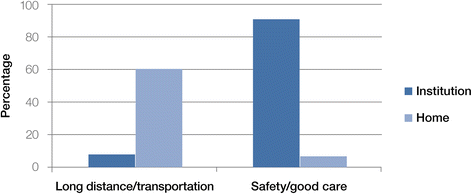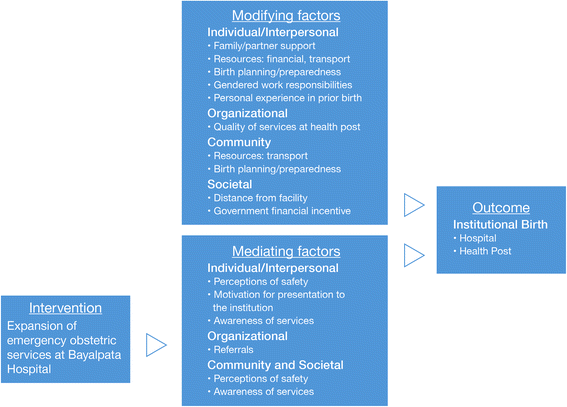Determinants of institutional birth among women in rural Nepal: a mixed-methods cross-sectional study
- PMID: 27567893
- PMCID: PMC5002328
- DOI: 10.1186/s12884-016-1022-9
Determinants of institutional birth among women in rural Nepal: a mixed-methods cross-sectional study
Abstract
Background: Encouraging institutional birth is an important component of reducing maternal mortality in low-resource settings. This study aims to identify and understand the determinants of persistently low institutional birth in rural Nepal, with the goal of informing future interventions to reduce high rates of maternal mortality.
Methods: Postpartum women giving birth in the catchment area population of a district-level hospital in the Far-Western Development Region of Nepal were invited to complete a cross-sectional survey in 2012 about their recent birth experience. Quantitative and qualitative methods were used to determine the institutional birth rate, social and demographic predictors of institutional birth, and barriers to institutional birth.
Results: The institutional birth rate for the hospital's catchment area population was calculated to be 0.30 (54 home births, 23 facility births). Institutional birth was more likely as age decreased (ORs in the range of 0.20-0.28) and as income increased (ORs in the range of 1.38-1.45). Institutional birth among women who owned land was less likely (OR = 0.82 [0.71, 0.92]). Ninety percent of participants in the institutional birth group identified safety and good care as the most important factors determining location of birth, whereas 60 % of participants in the home birth group reported distance from hospital as a key determinant of location of birth. Qualitative analysis elucidated the importance of social support, financial resources, birth planning, awareness of services, perception of safety, and referral capacity in achieving an institutional birth.
Conclusion: Age, income, and land ownership, but not patient preference, were key predictors of institutional birth. Most women believed that birth at the hospital was safer regardless of where they gave birth. Future interventions to increase rates of institutional birth should address structural barriers including differences in socioeconomic status, social support, transportation resources, and birth preparedness.
Keywords: Global health; Implementation research; Institutional birth rate; Maternal mortality; Nepal; Skilled birth attendants; Women’s health.
Figures
Similar articles
-
Impact of the roll out of comprehensive emergency obstetric care on institutional birth rate in rural Nepal.BMC Pregnancy Childbirth. 2017 Mar 4;17(1):77. doi: 10.1186/s12884-017-1267-y. BMC Pregnancy Childbirth. 2017. PMID: 28259150 Free PMC article.
-
Factors affecting institutional delivery in rural Chitwan district of Nepal: a community-based cross-sectional study.BMC Pregnancy Childbirth. 2015 Feb 13;15:27. doi: 10.1186/s12884-015-0454-y. BMC Pregnancy Childbirth. 2015. PMID: 25884164 Free PMC article.
-
Utilization of decentralized health facilities and factors influencing women's choice of a delivery site in Gida Ayana Woreda, western Ethiopia.PLoS One. 2019 May 17;14(5):e0216714. doi: 10.1371/journal.pone.0216714. eCollection 2019. PLoS One. 2019. PMID: 31100070 Free PMC article.
-
Determinants of skilled birth attendants for delivery in Nepal.Kathmandu Univ Med J (KUMJ). 2010 Jul-Sep;8(31):325-32. doi: 10.3126/kumj.v8i3.6223. Kathmandu Univ Med J (KUMJ). 2010. PMID: 22610739 Review.
-
Social determinants of health affecting utilisation of routine maternity services in Nepal: a narrative review of the evidence.Reprod Health Matters. 2018 Nov;26(54):32-46. doi: 10.1080/09688080.2018.1535686. Epub 2018 Nov 7. Reprod Health Matters. 2018. PMID: 30403932 Review.
Cited by
-
Measuring fidelity, feasibility, costs: an implementation evaluation of a cluster-controlled trial of group antenatal care in rural Nepal.Reprod Health. 2020 Jan 17;17(1):5. doi: 10.1186/s12978-019-0840-4. Reprod Health. 2020. PMID: 31952543 Free PMC article.
-
An integrated community health worker intervention in rural Nepal: a type 2 hybrid effectiveness-implementation study protocol.Implement Sci. 2018 Mar 29;13(1):53. doi: 10.1186/s13012-018-0741-x. Implement Sci. 2018. PMID: 29598824 Free PMC article.
-
Barriers and facilitators to institutional delivery in rural areas of Chitwan district, Nepal: a qualitative study.Reprod Health. 2018 Jun 20;15(1):110. doi: 10.1186/s12978-018-0553-0. Reprod Health. 2018. PMID: 29925398 Free PMC article.
-
Successful task shifting: a mixed-methods cross-sectional evaluation of an emergency obstetric care program to increase access to cesarean sections in rural Nepal.Glob Health Action. 2024 Dec 31;17(1):2429888. doi: 10.1080/16549716.2024.2429888. Epub 2024 Dec 3. Glob Health Action. 2024. PMID: 39625330 Free PMC article.
-
Prevalence and associated factors of caesarean section delivery: analysis from the Nepal Demographic and Health Survey 2022.BMJ Open. 2025 Mar 22;15(3):e090209. doi: 10.1136/bmjopen-2024-090209. BMJ Open. 2025. PMID: 40122542 Free PMC article.
References
-
- Ministry of Health and Population Nepal. New ERA. Macro International Inc . Nepal Demographic and Health Survey, 2006. Kathmandu: Ministry of Health and Population Nepal, New ERA, and Macro International Inc; 2007.
MeSH terms
LinkOut - more resources
Full Text Sources
Other Literature Sources
Medical



